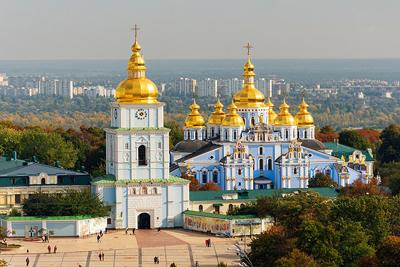
Located on the right bank of the Dnieper River, on the edge of a bluff northeast of the Saint Sophia Cathedral, the Saint Michael's Golden-Domed Monastery crowned with its shiny cupolas is an Orthodox men’s monastery in Kyiv or Kiev, the capital city of Ukraine, with a very long chequered history behind it. It is estimated that in the Middle Ages, Prince Iziaslav Yaroslavych built Saint Demetrius' Monastery and Church in the old upper city of Kiev, near Saint Sophia Cathedral in 1050, and between 1108 and 1113 his son, Sviatopolk II Iziaslavich, built a church at the monastery dedicated to his own patron saint, Michael the Archangel, and the monastery was regarded as a family abbey of Svyatopolk's family, where the members of the family were buried. Later, the monastery was mostly destroyed by the invading Tatars in 1240, who also removed the gold-plates from the domes of the damaged cathedral.
According to the available records, the monastery was reopened by 1496 and came to be known as Saint Michael's Golden-Domed Monastery, named after the church built by Sviatopolk II Iziaslavich. However, it was repeatedly restored and enlarged over the 16th century, and enjoyed the patronage of the hetmans or the chief of the armed forces, along with other benefactors, and acquired many valuable artifacts. Those invaluable pieces of art included the relics of Saint Barbara, brought to Kiev from Byzantium in the 11th century and kept in a silver sepulcher.

Constructed in 1108-1113 at the behest of Sviatopolk II Iziaslavic, the St. Michael's Golden-Domed Cathedral is the main and the largest of three churches of St. Demetrius Monastery. Modeled on the Assumption Cathedral of the Kiev Monastery of the Caves, the ancient cathedral used the Greek cross plan that included six pillars and three apses, adjoining a miniature church from the south. It is estimated that during those days, the cathedral had a single dome, although two smaller domes might have topped the tower and baptistery, and the interior decoration was lavish with high-quality shimmering mosaics.
However, while maintaining its original Byzantine interior, after several renovations and reconstructions, it had acquired a new baroque exterior by 1746. Six domes were added to the original single dome, and the added pressure on the walls was counteracted by the construction of buttresses. The monastery complex included, among others, a bell tower and three residences and refectories. The original wooden refectory of the monastery was replaced by a rectangular brick building, constructed in 1713, containing a dining hall for the brethren as well as several kitchens and pantries.

Almost all of the original Byzantine mosaics and frescoes on the interior walls that survived were painted over and given new life during the eighteenth and nineteenth centuries. The most striking treasure among them was the 12th-century intricate frescoes, like the Annunciation fresco and the beautiful mosaics, like the Angel mosaic, which were probably done by the local artisans, including the Master Olimpii. Despite many of those artistic creations were destroyed in the 13th to 16th century, some of them, notably the mosaics of Saint Demetrius of Thessalonika, Archdeacon Stephen, and the Eucharist survived and were partially restored in the late 19th century.

After the Soviet seizure of power, the monastery was closed during the anti-religious campaign of Stalin, and in 1934 the authority decided to demolish the entire monastery as little of the original Byzantine-style cathedral was preserved and it rather belonged to the Ukrainian Baroque style. It was also decided that it would be replaced with a new administrative building for the Ukrainian Soviet Socialist Republic. On 26 June 1934, work began with the removal of the twelfth-century Byzantine mosaics, some of which were deposited in the Tretiakov Gallery in Moscow or stored at the Saint Sophia Cathedral. The golden domes of the monastery were pulled down during the spring of 1935.
The silver royal gates of the cathedral, Mazepa's reliquary, or container for holy relics, made of silver and weighing two poods (around 37 kg), and many other valuables were sold abroad or simply destroyed. Finally, during the spring-summer period of 1936, the shell of the cathedral and bell tower was blown up with dynamite. The items stored at the Saint Sophia Cathedral were seized by the Nazis during the Second World War and transported to Germany. However, after the end of the Great War, the Americans discovered them and returned to Moscow.

However, the demolition of the monastery was deemed a crime after Ukraine regained independence in 1991, and voices were raised for the full-scale reconstruction of the monastery as an important part of the cultural heritage of the country and its people. While the plans were approved and carried out in 1997-1998, it was reported by the chief archaeologist for the site that more than 260 valuable ancient artifacts were recovered during excavations of the site before reconstruction. Apart from that, a portion of the ancient cathedral was found intact when uncovered and was added as a part of the current cathedral's crypt. While the restored bell tower was made an observation platform, a new electronic clock with hands and a set of chimes replaced the original chiming clock. The Cathedral was reconstructed last of all and decorated with a set of wooden baroque icons, copies of former mosaics and frescoes, and new works of art by Ukrainian artists.

Today, the newly built gold-domed blue church, the Saint Michael's Golden-Domed Monastery, standing at the other end of Proyizd Volodymyrsky is a fresh 2001 copy of the original structure, constructed in1108. Its fascinating history is exhibited and explained in great detail in a museum in the bell tower of the monastery.